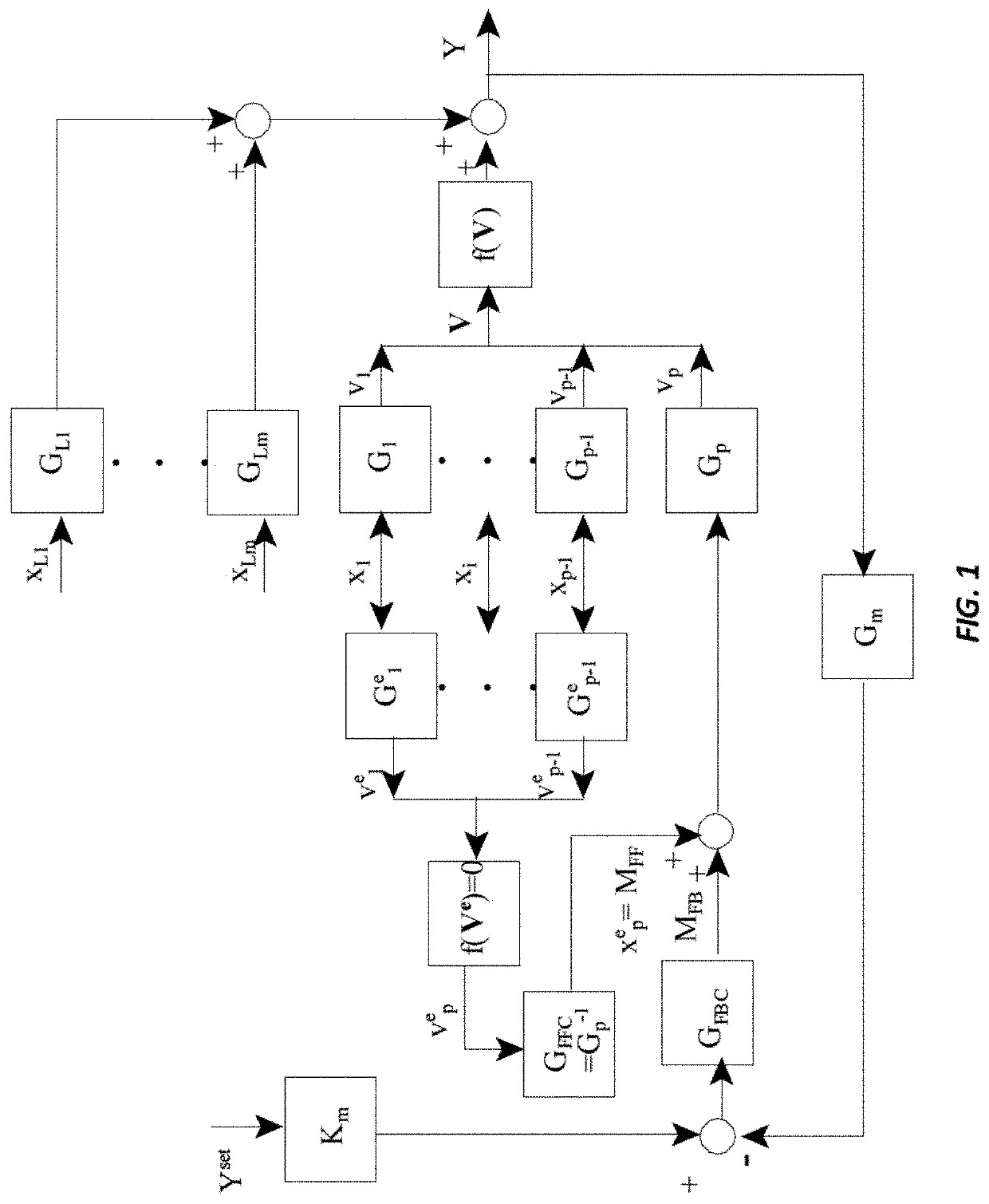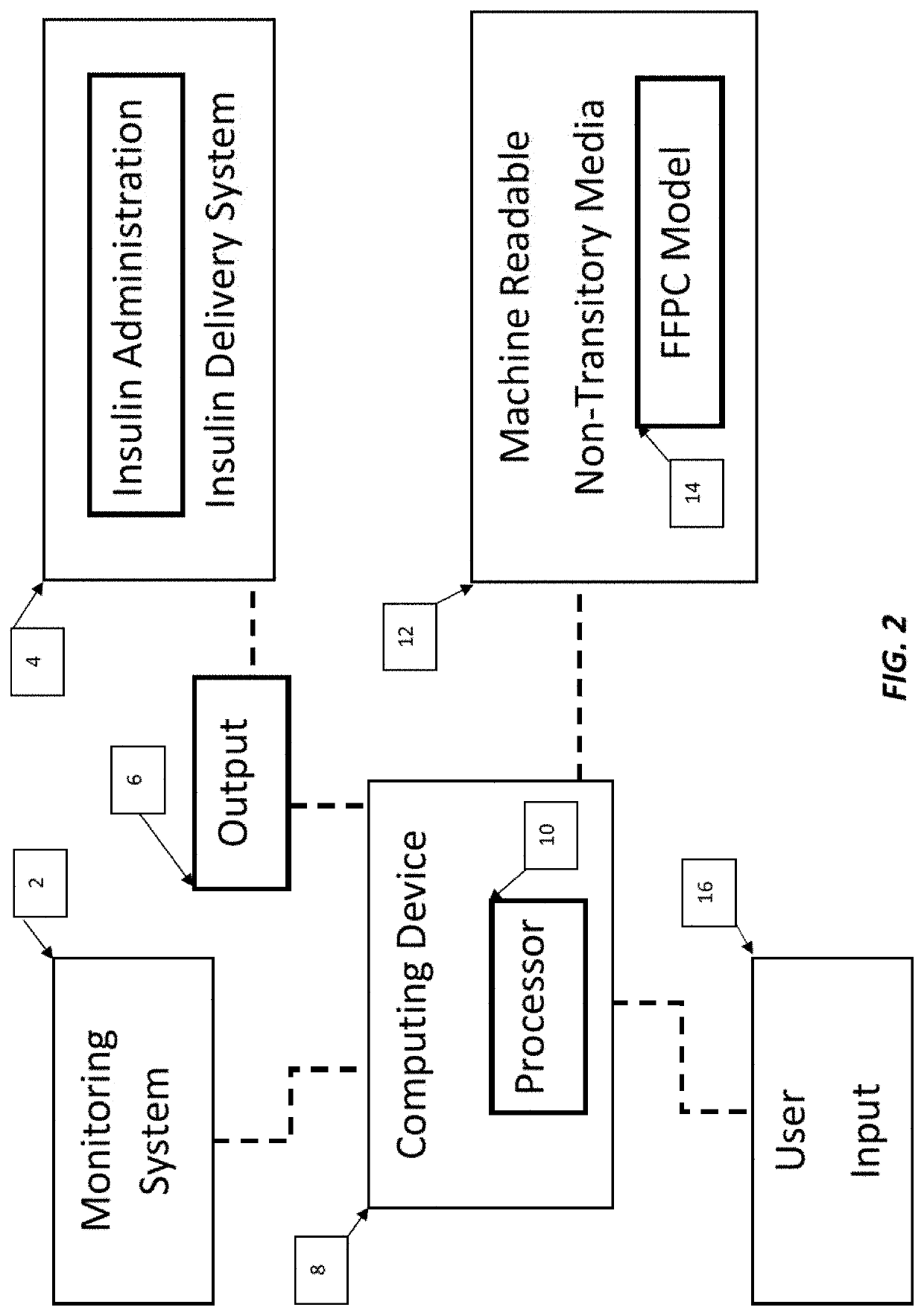Automatic insulin delivery system with minimized input variable lag
a technology of insulin delivery system and input variable, applied in the direction of adaptive control, instruments, peptide/protein ingredients, etc., can solve the problems of increased difficulty in glucose regulation and health management, increased difficulty in regulating glucose levels, and dysfunctional inherent glucose regulation mechanism, so as to improve the art. and/or overcome the deficiencies of the art, and the effect of nullifying the effect of any disturban
- Summary
- Abstract
- Description
- Claims
- Application Information
AI Technical Summary
Benefits of technology
Problems solved by technology
Method used
Image
Examples
example 1
[0065]Utilizing a continuous stirred tank reactor (CSTR) as a process model, the methods of the present invention were tested. A CSTR model was selected as its coupled network bears resembles the structure between carbohydrate amount ingested and IFR as shown in Equations 11 and 12:
[0066]dGdt=-{SG+X(t)}G(11)dXdt=p2I(t)-p3X(t)(12)
where “G” represents BGC (mg / dl); “I” represents BIC (unit / di); “X(t)” denotes remote insulin actions (1 / min); “SG” denotes glucose effectiveness (1 / min); “p2” represents fractional appearance rate of insulin in interstitial fluids; and “p3” represents fractional clearance rate of insulin in interstitial fluids. Both p2 and p3 are estimable parameters.
In comparison, the CSTR process shown in FIG. 2 is described by Equations 13-18.
[0067]dCAdt=FV(CAi-CA)-kCA2(13)dTTdt=FV(TT-TT)-ΔHRρCpkCA2-UAρVCp(TT-TC)(14)dTCdt=UAVCρCCpC(TT-TC)-FVC(TC-TCi)(15)k=k0exp(-ER(TT+273.16))(16)
FC=FCmax×a(−M) (17)
[0068]f(V^t)=a^0+a^1v^1,t-m...
example 2
[0072]Applying the methods of Example 1, three input variables of input signal to valve, M (x1); temperature of inlet coolant flow, Tci (x2); and concentration of component A in inlet flow, Cai (x3) were generated by sequential step tests as shown in FIG. 4. One output for this study is the measured tank temperature, Tm.
[0073]To identify the parameters of the methods of the present invention as contained within a Wiener model, training with 2700 minutes of simulation data was first conducted. With time delay implemented into a Wiener model, fitted tank temperature was collected and is shown in FIG. 5. With model parameters isolated, the effects of the present invention were examined by minimizing the variation of tank temperature around its set point of 88° C. by manipulating input signal to valve M. In particular, the effects of one disturbance, Tci was examined. When announcement for the disturbance was done, the Equation 19 was used. Otherwise, the most recent recorded value for ...
example 3
[0076]Applying the methods of Example 2, the effects of multiple disturbances were examined, i.e., disturbances of Tci and Cai. The results achieved according to the methods of Example 2 are shown in FIG. 7A, FIG. 7B, and FIG. 7C. FIG. 7A represents the tank temperature under feedback control alone. FIG. 7B represents the tank temperature by applying the methods of the present invention with the announcement of changing Tci, but without the announcement of changing Cai. FIG. 7C represents the tank temperature by applying the methods of the present invention with announcement of future Tci and Cai.
[0077]As shown, the variation of tank temperature around its set point is only slightly reduced by applying the methods of the present invention without announcement of Cai (but still with Tci announcement) by a proportion of about 8%. When applying the methods of the present invention with both Tci and Cai announcement, the reduction in set point variation increases to about 74%. The resul...
PUM
| Property | Measurement | Unit |
|---|---|---|
| temperature | aaaaa | aaaaa |
| concentration | aaaaa | aaaaa |
| skin temperature | aaaaa | aaaaa |
Abstract
Description
Claims
Application Information
 Login to View More
Login to View More - R&D
- Intellectual Property
- Life Sciences
- Materials
- Tech Scout
- Unparalleled Data Quality
- Higher Quality Content
- 60% Fewer Hallucinations
Browse by: Latest US Patents, China's latest patents, Technical Efficacy Thesaurus, Application Domain, Technology Topic, Popular Technical Reports.
© 2025 PatSnap. All rights reserved.Legal|Privacy policy|Modern Slavery Act Transparency Statement|Sitemap|About US| Contact US: help@patsnap.com



